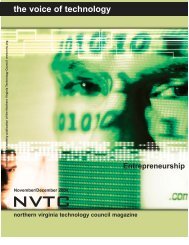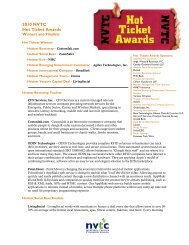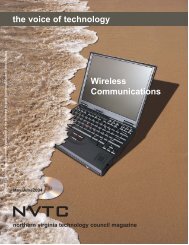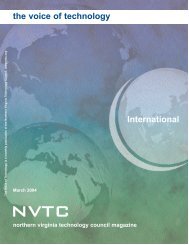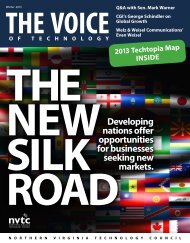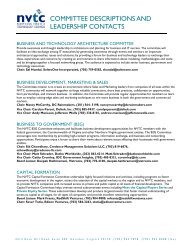Fall 2010 - Northern Virginia Technology Council
Fall 2010 - Northern Virginia Technology Council
Fall 2010 - Northern Virginia Technology Council
You also want an ePaper? Increase the reach of your titles
YUMPU automatically turns print PDFs into web optimized ePapers that Google loves.
Q&A with Bob Johnson, Mike Maiorana, Kyle McSlarrow and J.D. Myers<br />
The emergency response team has more than 25,000 mobile<br />
devices ready for deployment along with everything they need.<br />
And so we’re able to make sure that from a business continuity<br />
perspective, we would be their choice in times of emergency.<br />
KM: There’s no question business continuity is a huge need.<br />
It’s something that we’re very conscious of that we want to and<br />
can deliver.<br />
JDM: Business continuity comes in two different flavors for us.<br />
First is building network redundancy, with no single point of failure<br />
for the customer, to ensure that they’re up and running regardless<br />
of the circumstance.<br />
I talked previously about our 30 percent growth in wholesale,<br />
largely driven by wireless backhaul, where we are building what I<br />
consider seamless bulletproof networks so that when Sprint deploys<br />
these wireless networks in areas where there are disasters — ultimately<br />
that infrastructure, that data, or those wireless voice calls<br />
have to get back to a network. And that’s where we come into play<br />
to bring those signals back once they’ve deployed those networks<br />
so that information can get to where it’s supposed to reach.<br />
MM: Verizon Wireless is no stranger to disaster response and<br />
crisis management. We have a dedicated Crisis Response Team<br />
(CRT), we conduct hundreds of emergency drills each year, and<br />
we have responded to numerous real disasters, not just in this region,<br />
but across the country.<br />
Our network performed extremely well throughout the August<br />
hurricane and our sustained capital investment ensures that our<br />
network has redundancies to provide a framework for reliable service,<br />
even when power is not available. Most of our cell sites and<br />
switches have generator and battery backup. So when power is out,<br />
it doesn’t impact our network or our customers.<br />
Disaster recovery and business continuity depends on two<br />
things: the network and the people. And we are very proud that<br />
when customers need us most, we’re there. When we learned about<br />
the power being completely wiped out in New Kent and King and<br />
Queen Counties in <strong>Virginia</strong>, our people worked with these counties<br />
to provide immediate support. We quickly deployed our Verizon<br />
Wireless Experience Vehicle outfitted with work stations,<br />
electrical outlets, satellite capabilities for voice and data, voice over<br />
IP, phones and charging stations to help local governments and<br />
displaced citizens during this critical time. Our stores stayed open<br />
for consumers looking for extra batteries and charging adapters.<br />
So both our network and our people delivered.<br />
nvtc Where are your companies focusing for the future?<br />
BJ: First, Sprint has established itself as the differentiated highestvalue-offering<br />
service provider in wireless. We are the only carrier<br />
that continues to offer unlimited data and we have award-winning<br />
customer service and customer experience. We’ve got to continue<br />
to be that highest-value service provider for our customers, building<br />
out our first-to-market wireless 4G network from a national<br />
carrier to ensure that we have the greatest coverage and access for<br />
our customers, both consumer and enterprise.<br />
Transitioning in the 2013 timeframe, we will also continue<br />
to deploy our network vision program, which will give not only<br />
greater coverage, but also help Sprint be more cost competitive<br />
with expected reductions in network operating costs, working<br />
with some of our partners Cox and Comcast on next-generation<br />
back haul capabilities and having less reliance on accessing the<br />
local telecoms for back haul as well.<br />
JDM: From a Cox perspective, we remain focused on bringing innovation<br />
to the marketplace, by engaging our customers to make<br />
sure that we’re meeting their increasingly diverse and rapidly<br />
changing needs. Ultimately our customers are in control of our<br />
investments from a technology perspective. So we will continue to<br />
engage our customers to ensure that we continue to provide them<br />
with aggressive and value-based offerings and meet their growth<br />
and technology needs.<br />
We’re also focusing on expanding in areas like mobile viewing,<br />
providing greater on-demand viewing, continuing to provide the<br />
best HD offerings in the marketplace and further enhancing our<br />
evolving 3D offering.<br />
Last, but not least, we’re going to continue to focus on mobility<br />
as a priority for our consumer and business customers.<br />
KM: For Comcast, we have the advantage of the most robust national<br />
network in the country, hands down, which allows us a lot<br />
of flexibility in how to use that network to meet our customers’<br />
needs and demands. Interestingly, those demands are changing<br />
pretty quickly before our eyes. So there’s a huge requirement, as<br />
J.D. just mentioned, for us to be nimble and continue to innovate<br />
in meeting those new needs.<br />
Our goal is to be positioned to meet the plethora of different<br />
activities and trends that businesses are engaged in. Like Cox, we<br />
have seen tremendous growth over the last few years in the small<br />
to medium enterprise segment, so for the foreseeable future, we’re<br />
going to be very aggressive in that space.<br />
MM: As we are transforming our 4G LTE network, which by the<br />
end of 2013 will cover every market that’s currently served by 3G,<br />
we also are transforming our business through collaboration and<br />
openness. We’ve got an Open Development Program for thirdparty<br />
devices, an LTE Innovation Center up in Waltham, Mass.,<br />
our 4G Venture Forum, which is working with Google and Skype,<br />
China Mobile, SoftBank Japan and the overall Verizon developer<br />
community, and just this past month we opened our Application<br />
Innovation Center on the West Coast for developers to work on<br />
applications side by side with Verizon network experts.<br />
These partnerships and collaborations are the building blocks<br />
that will deliver even more innovation for our customers. And, as<br />
we expand this definition of a wireless device with M2M and add<br />
developers from around the world to create innovative apps, the<br />
potential to improve our lives through wireless technology is limitless,<br />
enabling each of us to work better, smarter and faster. nvtc<br />
Allison Gilmore is NVTC’s Director of Communications<br />
& Public Relations.<br />
<strong>Fall</strong> 2011 www.nvtc.org THE VOICE OF TECHNOLOGY 29






